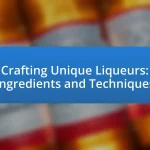The article focuses on the critical factors to consider when selecting a barrel for aging spirits, emphasizing the importance of wood type, toasting and charring levels, barrel size, and previous contents. It details how different wood types, such as American and European oak, influence flavor profiles and aging processes. Additionally, the article discusses the impact of barrel size on maturation speed and flavor development, as well as the significance of barrel provenance and previous contents in enhancing the final spirit’s character. Techniques for optimizing the aging environment and common mistakes to avoid when choosing barrels are also highlighted, providing a comprehensive guide for distillers and spirit enthusiasts.

What Factors Should You Consider When Choosing a Barrel for Aging Spirits?
When choosing a barrel for aging spirits, consider the type of wood, the level of toasting or charring, the barrel size, and the previous contents of the barrel. The type of wood, such as American oak or European oak, influences flavor compounds; for example, American oak imparts vanilla and coconut notes, while European oak adds spice and dried fruit flavors. The level of toasting or charring affects the extraction of flavors and the development of color; heavier charring can enhance caramelization and sweetness. Barrel size impacts the surface area-to-volume ratio, with smaller barrels aging spirits faster due to increased wood contact. Lastly, the previous contents, such as bourbon or sherry, can impart additional flavors to the spirit being aged. These factors collectively determine the final profile of the aged spirit, making them crucial in the selection process.
How does the type of wood influence the aging process?
The type of wood significantly influences the aging process of spirits by affecting flavor extraction, chemical reactions, and the permeability of the barrel. Different woods, such as oak, cherry, and maple, impart distinct flavors and aromas due to their unique chemical compositions. For instance, oak contains lactones and vanillin, which contribute to vanilla and coconut notes in aged spirits. Additionally, the wood’s porosity affects how oxygen interacts with the spirit, facilitating oxidation and evaporation, which are crucial for developing complexity and depth in flavor. Research indicates that American oak, with its higher vanillin content, produces sweeter and more robust flavors compared to European oak, which tends to yield spicier and more tannic profiles. This variation in wood type directly impacts the final character of the aged spirit, making the choice of wood critical in the aging process.
What are the characteristics of different wood types used in barrels?
Different wood types used in barrels have distinct characteristics that influence the aging process of spirits. Oak is the most common wood, known for its tight grain, which allows for slow oxygen exchange, enhancing flavor complexity. American oak imparts sweeter, vanilla notes due to higher lactone content, while European oak offers spicier, more tannic flavors, often associated with sherry cask aging.
Other woods, such as cherry and maple, can also be used; cherry adds a fruity profile, while maple contributes a subtle sweetness. The choice of wood affects not only flavor but also the rate of extraction of compounds like tannins and lignin, which are crucial for the spirit’s final character. The specific wood type, along with its treatment and toasting level, plays a significant role in determining the overall quality and taste of the aged spirit.
How does the toasting and charring of wood affect flavor?
Toasting and charring of wood significantly enhance the flavor profile of spirits aged in barrels. The process of toasting involves heating the wood to a specific temperature, which caramelizes the natural sugars and creates compounds that contribute vanilla, caramel, and spice notes. Charring, on the other hand, creates a layer of charcoal that filters impurities and adds smoky, rich flavors. Research indicates that the degree of toasting and charring can influence the extraction of flavor compounds, with lighter toasting yielding more fruity notes and heavier charring imparting deeper, more robust flavors. This transformation occurs due to the breakdown of lignin and cellulose in the wood, releasing flavor compounds such as lactones and phenols, which are crucial for the overall taste experience of the aged spirit.
What size of barrel is best for aging spirits?
The best size of barrel for aging spirits is typically 53 gallons, which is the standard size for American oak barrels used in whiskey production. This size allows for an optimal surface area-to-volume ratio, facilitating effective interaction between the spirit and the wood, which enhances flavor extraction and maturation. Research indicates that smaller barrels, while they can accelerate aging due to increased wood contact, may lead to over-oaking and undesirable flavors. Conversely, larger barrels, such as those exceeding 100 gallons, slow the aging process, which can result in a less pronounced wood influence. Therefore, the 53-gallon barrel strikes a balance, providing sufficient wood interaction while allowing for a controlled aging process.
How does barrel size impact the aging process and flavor development?
Barrel size significantly impacts the aging process and flavor development of spirits. Smaller barrels have a higher surface area-to-volume ratio, which accelerates the interaction between the spirit and the wood, leading to faster extraction of flavors and compounds such as vanillin and tannins. This results in a more pronounced wood influence and quicker maturation. Conversely, larger barrels provide a slower aging process, allowing for a more gradual integration of flavors and a subtler wood character, as the spirit has less contact with the wood per volume. Research indicates that spirits aged in smaller barrels can mature in a fraction of the time compared to those in larger barrels, with studies showing that whiskey aged in a 53-gallon barrel can take up to four times longer to achieve similar flavor profiles as those aged in a 5-gallon barrel.
What are the advantages and disadvantages of using smaller versus larger barrels?
Smaller barrels offer faster aging and more intense flavor extraction due to a higher surface area-to-volume ratio, while larger barrels provide a slower, more gradual maturation process and a subtler flavor profile. The rapid aging in smaller barrels can lead to over-oaking if not monitored, while larger barrels may require longer aging times to achieve desired flavor complexity. Research indicates that spirits aged in smaller barrels can mature in a fraction of the time compared to those in larger barrels, which can take years longer to reach optimal flavor balance.
What is the importance of barrel provenance in spirit aging?
Barrel provenance is crucial in spirit aging because it directly influences the flavor, aroma, and overall quality of the final product. The origin of the wood, including the type of oak and its previous use, affects the extraction of compounds such as tannins and vanillin, which contribute to the spirit’s character. For instance, barrels sourced from specific regions, like American oak from Missouri, impart distinct vanilla and caramel notes, while European oak from Spain may add spicier and fruitier elements. Historical data shows that spirits aged in barrels with a well-documented provenance often achieve higher ratings and consumer preference, underscoring the importance of barrel selection in the aging process.
How does the origin of the barrel wood affect the final product?
The origin of the barrel wood significantly influences the flavor, aroma, and overall character of the final product. Different types of wood, such as American oak, French oak, or Hungarian oak, impart distinct flavor profiles due to their unique chemical compositions and grain structures. For instance, American oak is known for its strong vanilla and coconut notes, while French oak tends to provide more subtle spice and fruit characteristics. Additionally, the geographic region where the wood is sourced can affect the wood’s tannin levels and the presence of specific compounds, such as lactones, which further shape the sensory attributes of the aged spirit. Studies have shown that the toasting and charring processes also interact with the wood’s origin, enhancing or modifying these flavor contributions, thus making the choice of barrel wood crucial for achieving desired outcomes in spirit aging.
What role do previous contents of the barrel play in flavor transfer?
Previous contents of the barrel significantly influence flavor transfer by imparting residual compounds into the new spirit. When a barrel has aged a specific type of liquid, such as whiskey or wine, it absorbs various flavor compounds, tannins, and aromatic substances from that liquid. During the aging process of a new spirit, these absorbed compounds leach back into the liquid, enhancing its flavor profile. For example, a barrel previously used for sherry can add notes of dried fruit and nuttiness to a whiskey aged in it. This phenomenon is supported by studies showing that the type of previous contents directly correlates with the complexity and character of the resulting spirit, as different liquids contribute unique flavor compounds that interact with the spirit during maturation.

What Techniques Can Enhance the Aging Process in Barrels?
Techniques that can enhance the aging process in barrels include controlling temperature and humidity, selecting the right wood type, and employing toasting or charring methods. Controlling temperature and humidity ensures a consistent environment that promotes optimal interaction between the spirit and the wood, which can lead to improved flavor extraction and maturation. The choice of wood, such as American oak or European oak, significantly influences the flavor profile, as different woods impart distinct characteristics due to their unique chemical compositions. Additionally, toasting or charring the interior of the barrel caramelizes the wood sugars, creating a layer of flavor compounds that enhance the spirit’s complexity during aging. These techniques are supported by industry practices that demonstrate their effectiveness in producing high-quality aged spirits.
How can you control the environment for optimal aging?
To control the environment for optimal aging of spirits, maintain consistent temperature and humidity levels in the aging area. Research indicates that ideal aging occurs at temperatures between 60°F and 70°F (15°C to 21°C) and humidity levels around 60% to 70%. These conditions prevent excessive evaporation and ensure proper interaction between the spirit and the barrel wood, enhancing flavor development. Additionally, minimizing light exposure and vibrations can further protect the aging process, as these factors can negatively impact the quality of the spirits.
What temperature and humidity levels are ideal for barrel aging?
The ideal temperature for barrel aging is between 55°F and 65°F (13°C to 18°C), while the optimal humidity levels range from 60% to 80%. Maintaining these conditions allows for proper interaction between the spirit and the wood, facilitating the extraction of flavors and compounds essential for aging. Research indicates that temperatures outside this range can lead to undesirable aging effects, such as excessive evaporation or insufficient extraction of tannins and vanillin from the barrel.
How does light exposure affect the aging process?
Light exposure accelerates the aging process of spirits by causing chemical reactions that can lead to undesirable flavors and colors. Specifically, ultraviolet (UV) light can break down compounds in the spirit, such as phenols and esters, which are crucial for flavor development. Research indicates that spirits stored in clear glass bottles exposed to light can experience significant changes in taste and quality within weeks, while those kept in dark or opaque containers maintain their integrity for longer periods. This phenomenon underscores the importance of minimizing light exposure during the aging process to preserve the desired characteristics of the spirit.
What methods can be used to monitor the aging process?
Methods to monitor the aging process of spirits include sensory evaluation, chemical analysis, and physical measurement. Sensory evaluation involves tasting and smelling the spirits at various intervals to assess flavor development and aroma changes. Chemical analysis, such as gas chromatography and mass spectrometry, quantifies compounds like esters and phenols that influence flavor and aroma, providing objective data on the aging process. Physical measurement techniques, including monitoring color changes and viscosity, offer additional insights into the maturation of spirits. These methods collectively ensure a comprehensive understanding of how aging affects the final product.
How can sampling and testing help in determining the right aging time?
Sampling and testing can significantly aid in determining the right aging time for spirits by providing empirical data on flavor development and chemical composition. Through regular sampling, distillers can analyze the sensory characteristics and chemical markers of the spirit at various aging intervals, allowing them to identify the optimal point where desired flavors and aromas are achieved. For instance, testing can reveal the influence of wood compounds, such as vanillin and tannins, which contribute to the overall profile of the spirit. This methodical approach ensures that the aging process is tailored to achieve specific taste profiles, ultimately leading to a more refined and desirable product.
What tools are available for measuring the chemical changes during aging?
Tools available for measuring chemical changes during aging include gas chromatography, mass spectrometry, and nuclear magnetic resonance spectroscopy. Gas chromatography allows for the separation and analysis of volatile compounds, providing insights into flavor and aroma changes. Mass spectrometry offers precise molecular identification and quantification of compounds, essential for understanding the chemical profile of aged spirits. Nuclear magnetic resonance spectroscopy enables the analysis of molecular structures and dynamics, revealing changes in chemical composition over time. These tools are widely used in the food and beverage industry to ensure quality and consistency in aged products.

What Common Mistakes Should Be Avoided When Choosing a Barrel for Aging Spirits?
Common mistakes to avoid when choosing a barrel for aging spirits include selecting the wrong wood type, neglecting the barrel’s previous use, and overlooking the importance of barrel size. Choosing the wrong wood type, such as using a barrel made from a wood that imparts undesirable flavors, can negatively affect the spirit’s profile. For instance, oak is preferred for its ability to enhance flavors, while other woods may not provide the same benefits. Neglecting the barrel’s previous use can lead to unwanted residual flavors; for example, a barrel previously used for sherry may impart sherry notes to a whiskey if not properly cleaned or chosen. Additionally, overlooking barrel size can impact the aging process; smaller barrels have a higher surface area-to-volume ratio, which can lead to faster aging and potentially overpowering flavors. Understanding these factors is crucial for achieving the desired flavor profile in aged spirits.
What are the pitfalls of using barrels that are too old or damaged?
Using barrels that are too old or damaged can lead to significant quality issues in the aging process of spirits. Old barrels may have lost their ability to impart desirable flavors and aromas, resulting in a bland or unbalanced product. Additionally, damaged barrels can introduce unwanted contaminants, such as mold or off-flavors, which can negatively affect the spirit’s taste and aroma. Research indicates that barrels older than five years often exhibit diminished flavor extraction capabilities, leading to a less complex final product. Furthermore, leaks in damaged barrels can cause evaporation losses, known as the “angel’s share,” which reduces the overall volume of the spirit and can alter its concentration and character.
How can barrel condition affect the quality of the aged spirit?
Barrel condition significantly affects the quality of aged spirits by influencing the extraction of flavors and compounds during maturation. Well-maintained barrels, which are properly charred or toasted, enhance the spirit’s complexity by imparting desirable notes such as vanilla, caramel, and spice. Conversely, barrels that are damaged, overly worn, or improperly stored can lead to undesirable flavors, such as excessive tannins or off-flavors from oxidation. Research indicates that the interaction between the spirit and the wood, including the barrel’s age and previous use, plays a crucial role in determining the final profile of the spirit, as evidenced by studies showing that spirits aged in new, high-quality oak barrels exhibit superior flavor characteristics compared to those aged in inferior or reused barrels.
What signs indicate that a barrel is no longer suitable for aging?
A barrel is no longer suitable for aging when it exhibits signs of excessive leakage, off-odors, or significant deterioration of the wood. Excessive leakage indicates that the barrel has lost its ability to contain liquid, which compromises the aging process. Off-odors, such as mustiness or sourness, suggest that the wood has absorbed undesirable compounds, negatively affecting the flavor profile of the spirits. Additionally, visible signs of deterioration, such as deep cracks or extensive wear, can compromise the structural integrity of the barrel, making it ineffective for aging. These indicators are critical for ensuring that the aging process remains optimal and that the quality of the spirits is maintained.
How can improper storage impact the aging process?
Improper storage can significantly hinder the aging process of spirits by exposing them to unfavorable environmental conditions. Factors such as temperature fluctuations, excessive light, and humidity levels can alter the chemical reactions that occur during aging, leading to undesirable flavors and aromas. For instance, high temperatures can accelerate evaporation and concentration of flavors, while low humidity can cause excessive loss of water, resulting in a harsher taste profile. Research indicates that optimal aging occurs within specific temperature ranges, typically between 60°F and 70°F, and deviations from these conditions can compromise the quality of the final product.
What are the consequences of poor barrel storage conditions?
Poor barrel storage conditions can lead to significant negative consequences, including spoilage of the contents, loss of flavor, and compromised quality. When barrels are stored in environments with excessive heat or humidity, the wood can expand and contract, leading to leaks and oxidation of the spirit inside. This oxidation can result in off-flavors and a decrease in the overall quality of the aged spirit. Additionally, inadequate ventilation can promote mold growth, which can contaminate the contents and render them undrinkable. Studies have shown that proper storage conditions are crucial for maintaining the integrity of the aging process, as fluctuations in temperature and humidity can alter the chemical composition of the spirit, ultimately affecting its taste and aroma.
How can you ensure barrels are stored correctly to maintain quality?
To ensure barrels are stored correctly to maintain quality, they should be kept in a controlled environment with stable temperature and humidity levels. Proper storage conditions prevent wood expansion and contraction, which can lead to leaks and spoilage. The ideal temperature range is typically between 50°F to 65°F (10°C to 18°C), and humidity should be maintained around 60% to 70%. Additionally, barrels should be stored upright to avoid contact with the ground, which can introduce contaminants. Regular inspections for signs of leakage or mold are also essential to uphold the integrity of the barrel and its contents.
What Best Practices Should You Follow When Selecting a Barrel for Aging Spirits?
When selecting a barrel for aging spirits, prioritize the type of wood, barrel size, and previous use. The wood type, such as American oak or European oak, significantly influences flavor profiles; for instance, American oak imparts vanilla and caramel notes, while European oak adds spice and dried fruit characteristics. Barrel size affects the surface area-to-volume ratio, with smaller barrels accelerating aging due to increased wood contact. Additionally, consider the barrel’s previous use; barrels that previously held bourbon or sherry can impart unique flavors to the spirit being aged. Research indicates that the interaction between wood and spirit during aging is crucial for developing complex flavors, making these factors essential in the selection process.
How can you evaluate the quality of a barrel before purchase?
To evaluate the quality of a barrel before purchase, inspect its construction, wood type, and previous use. High-quality barrels are typically made from oak, which is known for its ability to impart desirable flavors to spirits. Check for tight seams and no leaks, as these indicate good craftsmanship. Additionally, consider the barrel’s previous contents; barrels that have aged fine wines or spirits often enhance the flavor profile of new contents. Research shows that barrels used for bourbon or sherry can add unique characteristics to the aging process, making them preferable for certain spirits.
What resources are available for sourcing high-quality barrels?
High-quality barrels can be sourced from specialized cooperages, which are companies that manufacture barrels and often provide detailed information about the wood types and aging processes used. Notable cooperages include Seguin Moreau, Taransaud, and Demptos, which are recognized for their craftsmanship and quality control. Additionally, industry trade shows such as the Craft Spirits Conference and the American Distilling Institute’s annual conference offer networking opportunities with barrel suppliers and insights into the latest trends in barrel aging. These resources ensure access to barrels that meet specific aging requirements for spirits, supported by the cooperages’ reputations for quality and expertise in barrel production.


